
A principle founder of Viennese Actionism, Hermann Nitsch’s practice synthesizes performance, painting, sculpture and music. Centered on a total approach to art making that appeals to all senses (“Gesamtkunstwerk”), Nitsch began developing his Orgien Mysterien Theater (Theatre of Orgies and Mysteries) in 1957. Dionysian performances, which can be both gruesome and celebratory, include elaborate sacrificial rituals, painting actions, and large communal feasts set to the soundtrack of Nitsch’s originally composed scores. This site-specific exhibition realized by the artist features approximately 50 works dating from the mid-1960s, including large-scale installations, paintings, sculpture, works on paper, photographs, film and sheet music.
The Pharmacy (1965-2011) is an evolving presentation of Nitsch’s original artwork, found objects, and various relics fluently assembled with overarching thematic implications. A set of hand-drawn schematics – indicative of Nitsch’s academic fascination with color theory – hang above three vertically oriented cabinets erected in linear succession. Each cabinet is filled with relics of baroque Catholicism (a monstrance, various vestments and a chalice), placed amid oddities including stacked porcelain cups labeled with foodstuffs, jars filled with pigments and essences, test tube racks, surgical instruments and gauze. The Pharmacy installation expands into adjacent rooms to include sheets of originally composed music, photography, documentary film, and additional vestment assemblages. Overlapping spiritual, scientific and visual motifs are presented with archival precision, providing a new, symbolically charged aestheticism to the individual objects while underscoring a tradition of object veneration practiced by priests, doctors, mystics and artists.
After an action is completed, Nitsch describes the smocks he uses during performances as “sullied, besmirched, bedaubed, befouled, bedraggled, besmeared [and] bespattered”. In Station of the Cross (1990), a worn garment is mounted to a supporting canvas in a cruciform position and incorporated into the painting’s ground with a series of markings. The bodily and environmental excesses inherent to the related action, including dirt and sweat, appear in yellow and brown hues throughout the composition, organically signifying the body of the artist as a central visual element. In Schuettbild mit Malhemd (Pour-painting with painting-action-shirt) (2009), a crucified smock is affixed to a canvas saturated with a viscous, burgundy paint smeared and dripped over fading, organic stains. A Roman-style embroidered chasuble, delicately set on a wooden stand, is positioned in front of the canvas. The heavily painted smock stands in contrast to the pristine, neatly resting vestment.
Nitsch’s pouring actions, begun in 1960, were influenced by the 1956 “übermalung” paintings of fellow Actionist Arnulf Rainer, which feature a heavy, downward-flowing application of material across their surface. In Schüttbild (Pour-painting) (1990), a swath of rich purple oil paint descends and encircles the center of the canvas. The color has royal and religious connotations, as high-ranking Catholic clerics are adorned in purple-embroidered vestments during masses for Advent and Lent. Nitsch’s “pour paintings” often juxtapose a premeditated consideration for color theory and individual contemplation with the spontaneity of communal performance.
In the 1980s, Nitsch began making paintings on the floor to further develop an abstract, gestural style. In Splatter Painting (1983), oil paint is first thrown from the edges of the canvas, and then walked over by barefoot assistants under Nitsch’s instruction. The artist-directed, consecutive and overlapping actions of the assistants render the material so thick that the stretcher support is visible through the canvas. Paired with a heavily mixed pigment, the canvas documents a unique performance in tonal and physical complexity that directly corresponds to the action of the participants.
Untitled (Relic) (2011) is an artifact from Nitsch’s 132nd teaching action during which linen sheets were stained with blood and other ephemera after a public and participatory laceration of a pig carcass. The use of blood symbolizes life and death and draws associations to the human body, while the raised placement of the carcass when mounted points to rituals both ancient and liturgical. Similar to relics created during Nitsch’s first action completed fifty years earlier in Vienna, Untitled (Relic) possesses formal qualities more unruly than what can be achieved with traditional oil paint. An organic disintegration of material results in continuously changing tone and viscosity, and the presence of footprints suggests a performative movement of the sheet from the wall to the floor.
Das letzte Abendmahl (The Last Supper) (1976-1979) is a large-scale interpretation of the biblical passage in which Leonardo Da Vinci’s Vitruvian Man is centered within a group of twelve disciples. In Nitsch’s work, each figure is outwardly represented by muscle, organ and skeletal systems. Incorporated into the drawing are designs for fictional spaces in which Nitsch’s plays could ideally be enacted, and the internal structures of the figures are further abstracted and numbered as the composition progresses downward. The work’s conceptual and formal complexity relates to the biological and architectural vocabulary used in describing the setting of Nitsch’s tragedy, Die Eroberung von Jerusalem: “An artificial blood circulation system runs through all the corridors of [a] subterranean city. Arteries of various widths extend throughout all of the corridors and rooms.”
Hermann Nitsch (b. 1938, Vienna) studied at the Wiener Graphische Lehr-und Versuchanstalt from 1953 to 1958. His works are exhibited in the two Nitsch Museums in Mistelbach and Naples as well as in the Nitsch Foundation in Vienna and can be found in institutional collections worldwide. Nitsch currently lives and works at Prinzendorf Castle on the Zaya River, Lower Austria, as well as in Asolo, Italy.
--
For more information and images, please contact the Hall Art Foundation’s administrative office at info@hallartfoundation.org.
The exhibition is only accessible by guided tour.
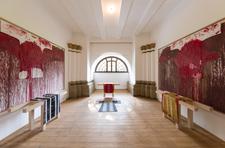
Installation View
Hermann Nitsch
Hall Art Foundation | Schloss Derneburg Museum
Derneburg, Germany
© Hall Art Foundation
Photo: Stefan Neuenhausen
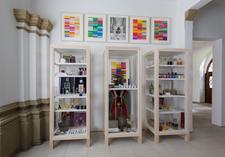
Hermann Nitsch
The Pharmacy, 1965-2011
Mixed media installation
Dimensions vary with installation
Hall Collection
© Hermann Nitsch
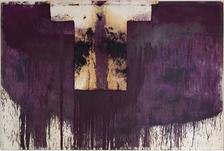
Hermann Nitsch
Station of the Cross, 1990
Oil, fabric on burlap
200 x 300 cm (78 ½ x 118 inches)
Hall Collection
© Hermann Nitsch
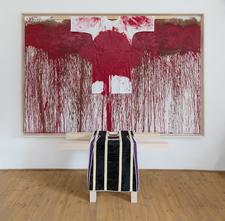
Hermann Nitsch
Schuettbild mit Malhemd (Pour-painting with painting-action-shirt), 2009
Acrylic, blood on burlap with fabric
201 x 300 cm (79 x 118 inches)
Hall Collection
© Hermann Nitsch
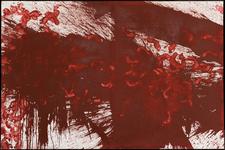
Hermann Nitsch
Splatter Painting, 1983
Oil on canvas
202.5 x 303 cm (79 ½ x 119 ½ inches)
Hall Collection
© Hermann Nitsch
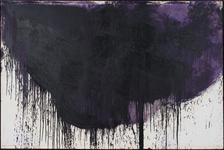
Hermann Nitsch
Schüttbild (Pour-painting), 1990
Oil on burlap
200 x 300 cm (78 ½ x 118 inches)
Hall Collection
© Hermann Nitsch
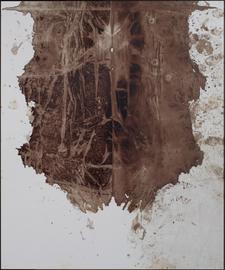
Hermann Nitsch
Untitled (Relic), 2011
Cloth, stained with blood
245 x 201.5 cm (96 ½ x 79 ½ inches)
Hall Collection
© Hermann Nitsch

Hermann Nitsch
Das letzte Abendmahl (The Last Supper), 1976-1979
Graphite and ballpoint pen on paper laid down on canvas
152 x 368 cm (60 x 145 inches)
Hall Collection
© Hermann Nitsch
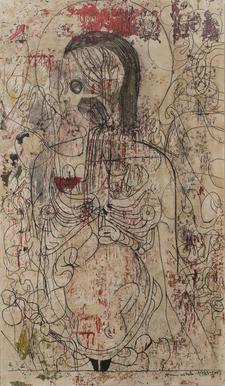
Hermann Nitsch
Design for "Grablegung (Burial)", 1983-2007
Relic, drawn on with marker on board
210 x 122 cm (82 ½ x 48 inches)
Hall Collection
© Hermann Nitsch